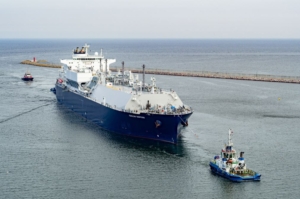LNG Carriers Order Portfolio – 50% of the fleet in operation
 LNG Terminal Świnoujście
LNG Terminal Świnoujście
By Marek Grzybowski
Alternative fuel vessels have accounted for around 60% of new orders since early 2022 in GT, driven mainly by bi-fuel LNG and increasingly methanol orders, and now account for 5% of fleet GT and 47% of orders according to Clarksons Research.
Liquefied gas tankers make up a large proportion of these vessels. The fleet of LNG carriers currently consists of about 657 units and can transport 100.23 million m3 of gas at a time, according to the latest report by Banchero Costa analysts as of July 2023.
Of these, 567 units (86% of the fleet) are standard size tankers ranging in capacity from 120,000 to 120,000 tons. to about 200,000 m3. Only 45 units have LNG tanks with a capacity of 120,000 m3. m3 (Small Scale units). The same number, 45 tankers have tanks with a capacity exceeding 200,000 m3. m3. These are the so-called Q-Flex / Q-Max.
LNG carriers in the shipbuilding portfolio
On a global scale, orders for LNG carriers are the most popular. According to the latest data from Clarksons Research, the global order backlog now corresponds to the “moderate” 10% of the fleet that is in operation.
However, the variation in each category is considerable. The portfolio of orders for oil tankers constitutes only 4% of the tanker fleet. In the case of bulk carriers it is 7% of the fleet, for container ships this share is 29% of the container fleet. In the case of LNG carriers, Clarksons analysts estimated that it is 50% of the LNG fleet in operation, and Danish Ship Finance A/S estimated that it is almost 55%.
– The reasons for the LNG procurement are obvious to everyone – it’s a viable nautical mile pipeline replacement, which is likely to last, as ships [allow flexible – MG] choice of suppliers and the world now feels much less secure [in terms of security of gas supply – MG] – assesses the situation Andrew Craig-Bennett, the main Splash columnist, commenting on the order book for LNG carriers.
Full docks of LNG tankers
The stuffed contract portfolios of container and gas carrier owners, which have accumulated over the past few years, please shipyard workers from the Republic of Korea and China, because they filled the shipyard docks. At the same time, they made it difficult for oil tankers and bulk carriers to renew their fleets.
But that could change soon, Braemar brokers believe. They noted that recently prices for new LNG carriers have reached a record high of USD 259.5 million for a standard vessel, which is currently discouraging some operators from contracting a larger series. And it should be noted that 20% of the fleet sails under the Japanese flag, 15% currently bears the marks of shipowners from Greece on their funnels, and 12% is managed by operators from the PRC, according to Banchero Costa and announcing: in 2023, these fleets will receive about 35 vessels, in 2024 – 71 vessels, and in 2025 – 88 LNG carriers.
Despite the limited number of ships, the LPG market performed better than expected. Exports of LNG from the USA increased significantly, which was also noticeable in the LNG terminal in Świnoujście, which received record-breaking gas loads from the United States. Despite the LNG shipping market, Clarksons experts believe that the program of building new VLGCs should be “watched”.
Polish LNG service
At the end of June, the second ship from the fleet of gas tankers chartered by the ORLEN Group arrived in Świnoujście. The about 65,000 to Poland. tons of LNG. Loading took place at the Freeport terminal on the Gulf of Mexico, south of Texas City. The contract for the supply took place on the spot market.
The first LNG carrier “Lech Kaczyński” called at the LNG terminal in Świnoujście in March this year. The unit chartered by PGNiG delivered approx. tons of liquefied natural gas imported from the USA. It was the first of eight methane carriers ordered by PGNiG.
– Another unit from the fleet built for the needs of the ORLEN Group has started its service on international waters as planned, strengthening the company’s position on the global liquefied natural gas market. Diversification of directions and sources of raw material supplies and independence in transport management guarantee energy security. The use of our own fleet ensures the stability of LNG supplies to Poland, and at the same time increases the operational flexibility of the concern – said Daniel Obajtek, President of the Management Board of PKN ORLEN.
